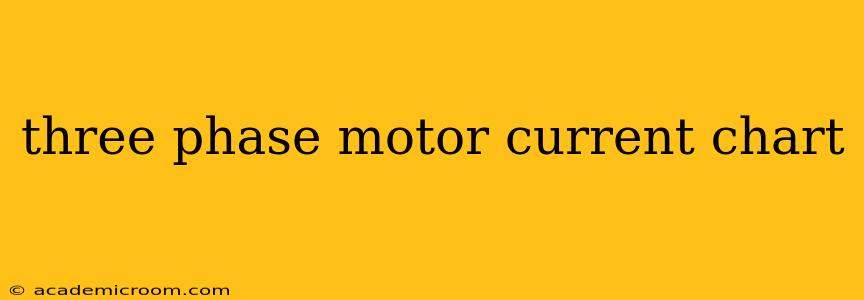Understanding the current draw of your three-phase motor is crucial for efficient operation, preventing damage, and ensuring safety. A three-phase motor current chart, while not a single, universally applicable document, represents the relationship between the motor's load, its power output, and the resulting current consumption. This guide will help you understand how to interpret and utilize this data.
What is a Three-Phase Motor Current Chart?
A three-phase motor current chart (often included in the motor's specifications or manufacturer's documentation) visually represents the expected current draw at various load levels. The chart typically plots the current (in Amps) on the y-axis against the motor's percentage of full-load or horsepower output on the x-axis. It provides a quick reference for determining the expected current at any given operational condition.
Why is Understanding Motor Current Important?
Monitoring the current drawn by your three-phase motor is vital for several reasons:
- Overload Protection: Excessive current indicates an overload condition. This could damage the motor windings, leading to costly repairs or replacements.
- Troubleshooting: Deviations from the expected current can pinpoint problems like mechanical binding, bearing wear, or electrical faults.
- Efficiency Analysis: By comparing the actual current draw to the values on the chart, you can assess the motor's efficiency and identify potential areas for improvement.
- Sizing Electrical Components: The chart helps determine the appropriate size of circuit breakers, fuses, and other electrical components to protect the motor.
How to Interpret a Three-Phase Motor Current Chart
Most charts will show several key pieces of information:
- Full-Load Current (FLA): This is the current drawn by the motor when operating at its rated horsepower or power output under normal conditions. This is a critical value for sizing your electrical system.
- Locked Rotor Current (LRC): Also known as starting current, this represents the significantly higher current draw when the motor is initially energized. Understanding LRC is essential for selecting appropriate motor starters and overload protection devices.
- Current at Different Load Levels: The chart will show how the current varies as the motor's load changes (from no-load to full-load). This allows for monitoring the motor's performance under different operating conditions.
Where Can I Find a Three-Phase Motor Current Chart?
The most reliable source for a three-phase motor current chart is the motor's nameplate. This metal plate affixed to the motor body usually provides critical information, including the FLA, voltage ratings, and sometimes a simplified current chart or reference to more detailed specifications. If the nameplate is missing or illegible, consult the manufacturer's documentation or contact the motor supplier.
What Factors Affect Three-Phase Motor Current?
Several factors influence a three-phase motor's current draw:
- Load: The primary factor affecting current. Higher loads demand higher currents.
- Voltage: Variations in supply voltage can affect current draw; lower voltages often lead to higher currents.
- Power Factor: A lower power factor (lagging) increases the current required to deliver the same amount of power.
- Motor Efficiency: A less efficient motor will draw more current than a more efficient one for the same output power.
- Temperature: Higher ambient temperatures can slightly increase current draw.
How to Monitor Three-Phase Motor Current
Monitoring the current is best done with dedicated motor monitoring equipment, such as:
- Ammeters: These devices measure the current in each phase separately.
- Motor Control Centers (MCCs): Often include ammeters or current monitoring capabilities.
- PLC-based systems: Programmable Logic Controllers can monitor and record current data for analysis.
Troubleshooting High Current Draw
If your three-phase motor is drawing significantly more current than indicated on the chart, several problems may exist:
- Mechanical Problems: Bearings are worn, or there's excessive friction in the load.
- Electrical Faults: Winding problems, shorted coils, or other internal faults.
- Overloading: The motor is being asked to do more work than it is rated for.
- Voltage issues: Low voltage supply.
Always investigate high current draws promptly to prevent damage and maintain safety.
This detailed explanation should provide a comprehensive understanding of three-phase motor current charts and their significance. Remember to always consult the motor's documentation for specific information related to your particular motor.
